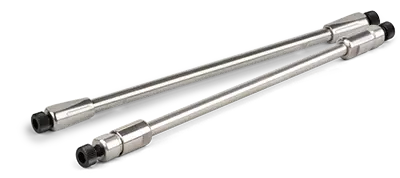
Polymeric HPLC Columns
Introduction to Polymeric HPLC Columns
Polymeric HPLC columns are essential in chromatography for separating and analyzing a wide range of compounds. Made from materials like polymethacrylate or polystyrene-divinylbenzene, they offer unique advantages over traditional silica-based columns, including exceptional stability, durability, and a wide pH range. Unlike silica-based columns, polymeric columns can withstand highly acidic or basic conditions, allowing for the analysis of samples with extreme pH values. These columns are widely used in pharmaceuticals, environmental analysis, and the food and beverage industry, particularly for organic acids, sugars, and non-water soluble polymers. Their unique selectivity and efficiency enable accurate and reproducible separations, leading to reliable analytical results. At Phenomenex, we offer a diverse range of polymeric HPLC columns designed to meet the needs of scientists and researchers. Our columns deliver exceptional performance and ensure optimal separations.

Polymeric vs. Silica HPLC Columns: Key Differences and Applications
When it comes to high-performance liquid chromatography (HPLC) columns, two popular options are polymeric and silica columns. Understanding their differences is crucial for selecting the right one for your analytical needs.
Polymeric HPLC Columns:
- Made from polymer material, offering unique advantages over silica columns.
- Surface Chemistry: Non-polar or weakly polar surface, ideal for separating non-polar compounds. Used in specific separation modes like GPC (gel permeation chromatography) and IEC (ion exclusion chromatography).
- Limitations: Not suitable for highly polar compounds due to non-polar surface. Higher backpressure can impact flow rate and system performance. Lower efficiency for reversed phase chromatography due to broad pore size distribution.
Silica HPLC Columns:
- Polar surface, suitable for separating polar compounds.
- Advantages: Higher efficiency for reversed phase chromatography. Better performance with highly polar compounds.
Choosing Polymeric HPLC Columns:
- Applications: Useful for GPC, IEC, and reversed phase chromatography when extremes of pH are required.
- Considerations: Specific requirements of your analysis. Consult experts to determine the most appropriate column.
How to Choose the Right Polymeric HPLC Column for Optimal Results
Selecting the right polymeric HPLC column is crucial for optimal separation and analysis. Consider these factors:
- Applications: Type of Polymeric Stationary Phase: Hydrophilic phases for polar compounds, hydrophobic phases for nonpolar compounds. Understand your analytes to choose the right phase.
- Particle Size: Smaller particles provide higher efficiency and better resolution but may increase backpressure. Balance efficiency and backpressure.
- Column Dimensions: Longer columns offer higher resolution but increase analysis time. Internal diameter affects flow rate and sample amount. Choose dimensions that suit your needs.
Tips for Optimizing Separations:
- Properly equilibrate the column before analysis for reproducible results.
- Optimize mobile phase composition, pH, and temperature to enhance efficiency and selectivity.
- Regularly maintain the column by flushing with appropriate solvents to prolong its lifespan.
At Phenomenex, we offer a range of polymeric HPLC columns designed to meet your specific analytical needs. Our expert team can provide guidance and support in selecting the right column for your applications. Contact us today to learn more about our polymeric HPLC column options.












